#Alberta history
Explore tagged Tumblr posts
Text
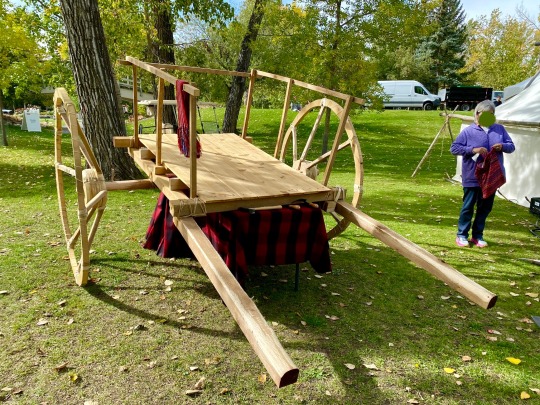
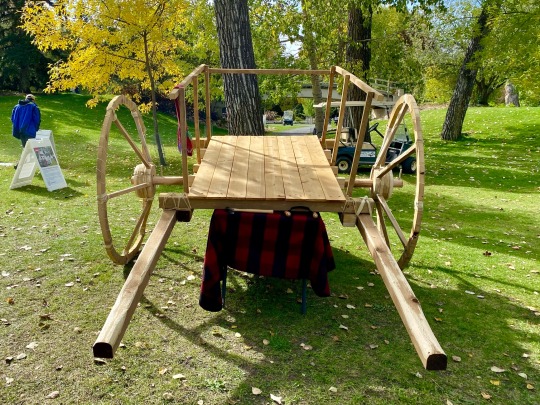
françoise (red river cart), 2023
My second red river cart built for the city of Calgary's parks educational programming about local Métis Otipemisiwak history. The cart is propped up for stability while it is not in use and because there was a last minute problem with a spoke that I will be repairing so that the cart will be able to function for years to come! It accomanies a Métis Otipemisiwak trappers tent and several large vinyl panels of archival material for education. I also delivered the following speech after Elder D. D. spoke some beautiful words and M. H. introduced me and fellow artist D. P. who created beaded and illustrated borders in the style of historic Michif beadwork for the selected archival images.
Taanishii kiiyawow? riel s. dishinikashoon. Hello, how are you all? my name is riel s. and i descend maternally from seven Métis Otipemisiwak families from the historic Red River Settlement and Batoche. Notably my Berthelet ancestors were community leaders in Pointe à Grouette, now Ste. Agathe, MB. Throughout this project I thought often of my 5th great uncle Jean Caron Sr. who fought in the North-West Resistance of 1885 in which his house was burnt down. It was later rebuilt in 1891 and it still stands in Batoche to this day. I introduce myself in this way, the traditional way of the Métis Otipemisiwak to contextualize my knowledge and experiences, situate myself on this land, and honour my family.
The red river cart is a symbol of Michif (Métis Otipemisiwak) ingenuity and survivance. From the land it rises and to the earth it will decompose again, not leaving a trace, not a nail or a screw. I built my first cart in 2022 during my undergrad as I considered histories of road allowance, trade, and Michif material culture's place in contemporary art. It is the vessel that carried us across our vast homelands and beyond, and cradled our young nation, serving us in our fight for sovereignty, dignity, and respect.
I would like to thank my friend C. for their assistance in parts of the building process, as well as their trust, friendship, and curiosity. I would also like to thank M. H. and D. P. for this opportunity and your guidance as mentors and your friendship. Maarsii.
#Métis/Otipemisiwak/Michif all refer to the same people lol#srry it's confusing#Metis Otipemisiwak is the legal name#michif is another name and the name of our language#my work#artwork#archive#archival work#historical interpretation#Métis#michif#history#alberta history#indigenous#fnmi#indigenous history#first nations#canada#canadian history#canadian art#contemporary art#traditional art#woodworking#western#western art#fur trade#my writing#poetry#artist#art
47 notes
·
View notes
Text
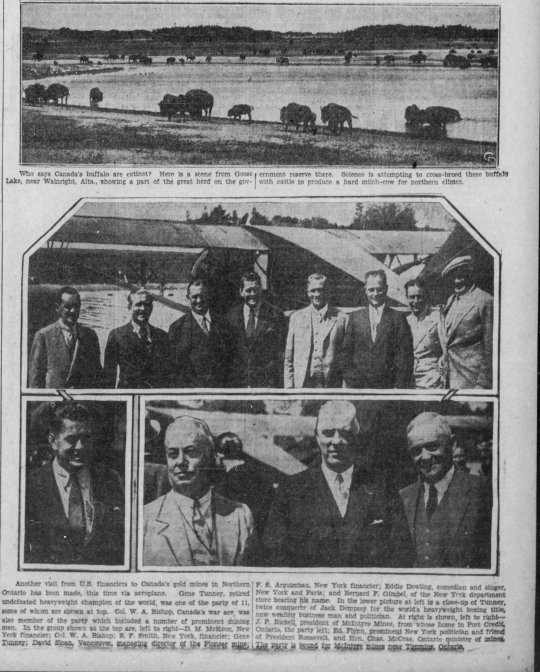
"Who says Canada's buffalo are extinct? Here is a scene from Goose Lake, near Wainright, Alta, showing a part of the great herd on the government reserve there. Science is attempting to cross-breed these buffalo with cattle to produce a hard milch-cow for northern climes.
////
Another visit from US financiers to Canada's gold mines in Northern Ontario has been made, this time vis aeroplane. Gene Tunney, retired undefeated heavyweight champion of the world, was one of the party of 11, some of whom are shown at top. Col. W. A. Bishop, Canada's war ace, was also member of the party which included a number of prominent shining men. In the group shown at the top are, left to right - D. M. McKeon, New York financier; Col. W. A. Bishop; B. F. Smith, New York, financier; Gene Tunney, David Sloan, Vancouver, managing director of the Plonser mine, P. S. Arguimbau, New York financier; Eddle Dowling, comedian and singer, New York and Paris: and Heard P. Gimpel, of the New York department store bearing his name. In the lower picture at left is a close-up of Tunney, twice conqueror of Jack Dempsy for the world's heavyweight boxing title, now wealthy business man and politician. At right is shown, left to right - J. P. Bickell, president of McIntyre Mines, from whose home in Port Credit, Ontario, the party left; Ed Flynn, prominent New York politician and friend of President Roosevelt, and Hon. Chas. McCrae, Ontario minister of mines. The party bound for McIntyre mines near Timmins, Ontario."
- from the Kingston Whig-Standard. June 26, 1933. Page 10.
#northern ontario#timmins#mining company#financial capitalism#stock promoter#financiers#famous athlete#billy bishop#capitalism in canada#gold rush#resource capitalism#great depression in canada#northwestern ontario#resource extraction#vancouver#port credit#bison#the passing of the buffalo#alberta history
25 notes
·
View notes
Text
We don't talk about how hard Matt goes for Halloween. Modern Halloween as we know it is very much a Canadian creation. The term "trick or treat" was 'invented' in Alberta.
Just Matt going all out for Halloween
5 notes
·
View notes
Text
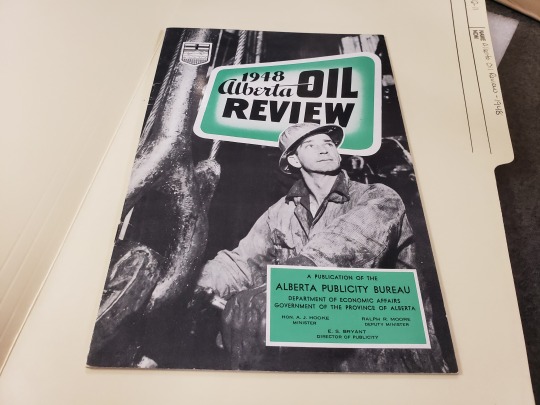
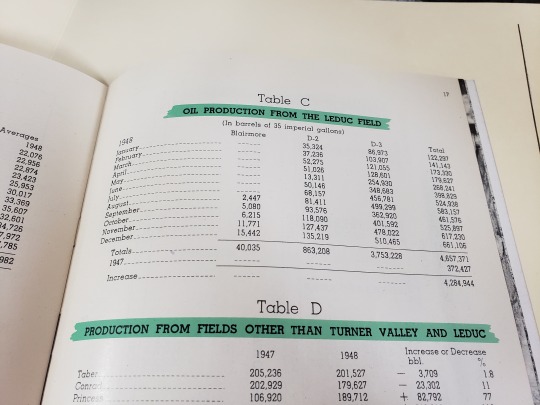
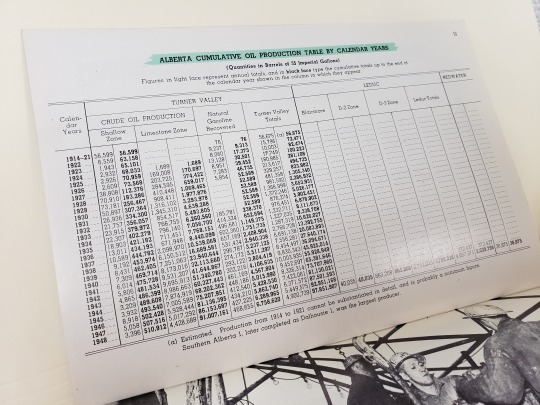
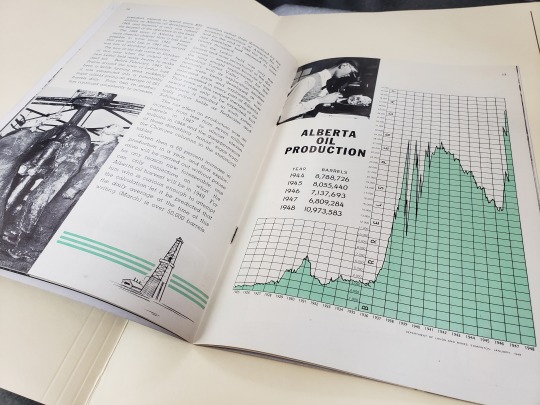
1948 Alberta Oil Review A Publication of the Alberta Publicity Bureau
It's a quiet Saturday at the museum front desk, so I'm using the time to look through some of our collection's old publications, compiling information I can incorporate into the new exhibit.
This lovely little booklet beautifully lays out the state of oil production in Alberta for 1948. Am I partial to it because of its use of turquoise? Maybe. But beyond that it's a great snap-shot of the impact the Leduc oilfields had on the industry less than 2-years in. And it has graphs. I love graphs.
#Canadian Energy Museum#CEM#Museum#Alberta#Leduc#Alberta History#History#Oil Industry#1940s#20th Century#Post-WWII#Mid-20th Century#Mid Century#turquoise#Social History#Local History#Edmonton#Devon#Devon AB#Publication#Research#Exhibit#Exhibition#Exhibit Planning#museology
2 notes
·
View notes
Text

Marilyn Monroe poses with some trash raiders.
Banff, Alberta
1953
#vintage camping#campfire light#alberta#banff national park#history#camping#bears#marilyn monroe#norma jean#1950s
1K notes
·
View notes
Photo
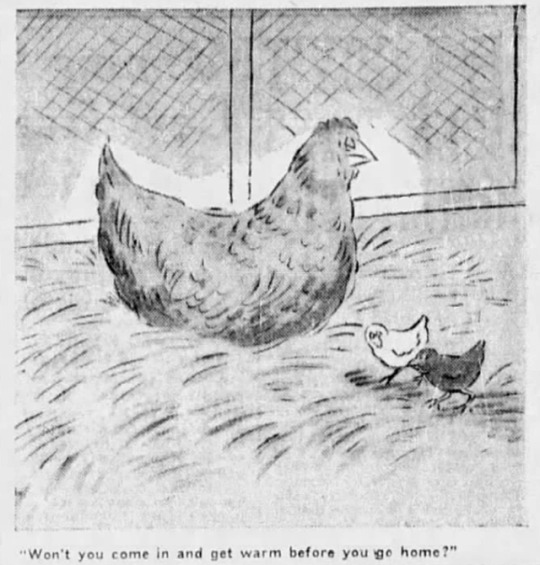
Calgary Herald, Alberta, March 3, 1936
1K notes
·
View notes
Text
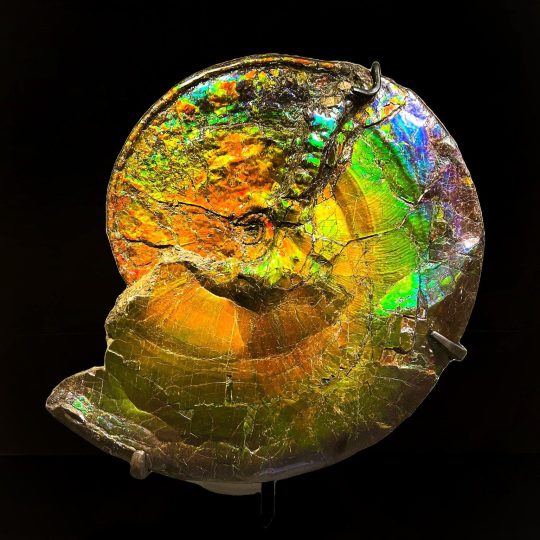
Behold the dazzling colors of an iridescent ammonite (Placenticeras intercalare)! A relative of today’s squids, this ammonite lived some 80 million years ago near what is now Alberta, Canada. This fossil’s spectacular coloration is the result of millions of years of high temperatures and pressures. As these forces acted on nacre in this ammonite’s shell, it was transformed into a gemstone known as an ammolite. Along with amber and pearl, ammolite is one of only a handful of gems made by living organisms. You can spot this rare specimen in the Louis V. Gerstner, Jr. Collections Core in the Museum’s Richard Gilder Center for Science, Education, and Innovation!
Photo: © AMNH
#amnh#museum#science#nature#fossil#natural history#animals#paleontology#ammonite#ammolite#did you know#fact of the day#rainbow#cool animals#alberta#pride#iridescent#cephalopods#squid#ancient animals
1K notes
·
View notes
Text
The University of Alberta is offering a new free online course to highlight the history and accomplishments of Black Canadians.
Called Black Canadians: History, Presence, and Anti-Racist Futures,the course will explore topics like systemic racism and unconscious racial bias in Canadian institutions.
The course became available Friday.
Course director Andy Knight, a political scientist at the U of A and provost fellow in Black excellence and leadership, spoke with Radio Active host Jessica Ng about the four-module course. [...]
Continue Reading for interview.
Tagging: @politicsofcanada, @vague-humanoid
2K notes
·
View notes
Text
Heart Creek Bunker | Alberta Hikes
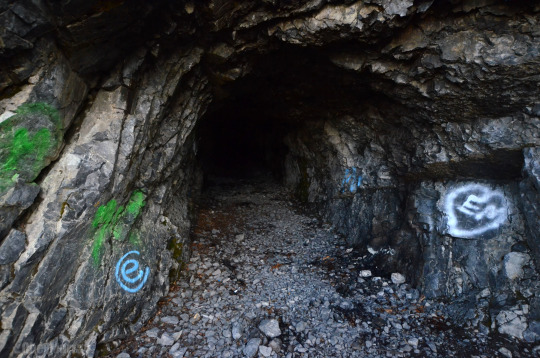
Hike Type: Easy, Busy
Location: Bow Valley Provincial Park, Alberta, Canada
Notes: Bring bear spray and a flashlight.
Within Alberta is a man-made cave known as "Heart Creek Bunker." According to local lore, it was intended to be a nuclear shelter, but was never completed. That is mostly the truth. It was dug out by two brothers, Joe and Stan Rokosh, who had dreams of turning it into a storage facility. While they do mention the possibility of use for disasters, their main goal was storage.
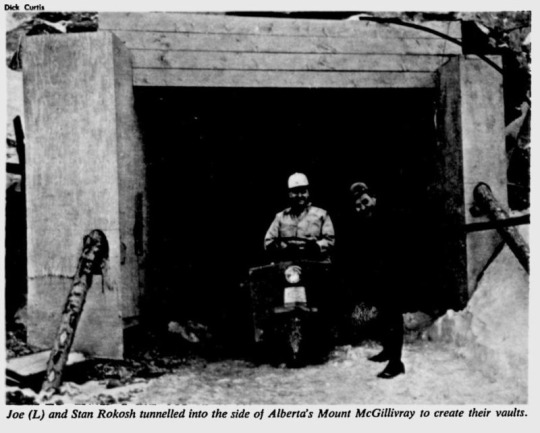
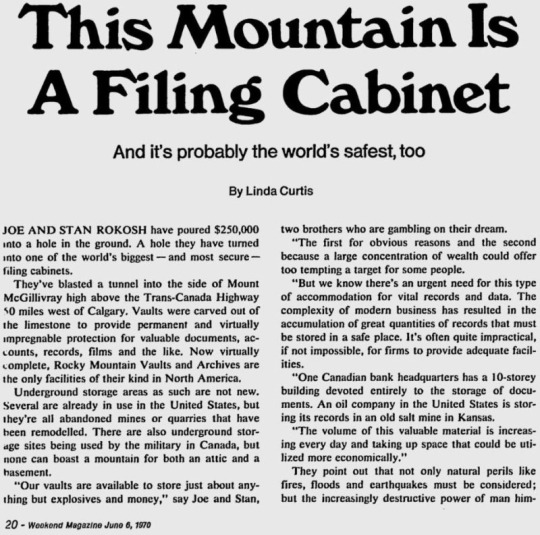
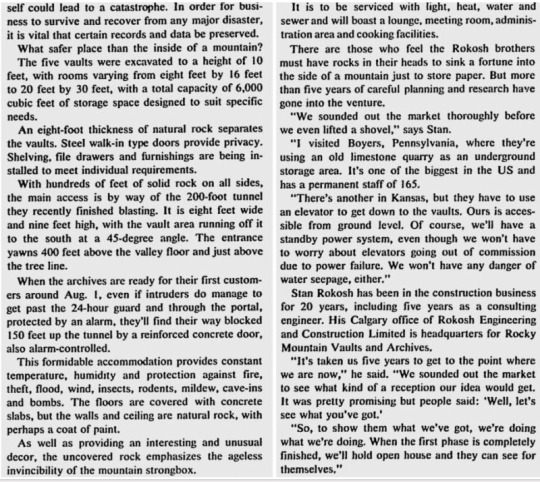
To get there, I first parked at Heart Creek day-use area, and followed the Trans-Canada trail. It has been many years since I was last there (2015), and much of the trail was washed out by flooding, but keeping left on the trails was all it took to reach the cave.
The Caves themselves are shallower than you might expect, with two dead-ends, and the walls were littered with spray-paint and used candles.
If you decide to go yourself, do note that I did spot a bear print, so be sure to bring bear-spray. Also, don’t forget a flashlight!

#alberta#albertahike#albertahikes#albertahiking#alberta history#hikes#hiking#outdoors#canada#TravelAlberta
0 notes
Text
Huh. I know Mr. Williams couldn't have seen COVID coming. But it is funny (in a sad way) that the first thing I thought of was "oh, so he'd be against anti-masking, right?" It wasn't until I looked at your tags that I realized this was talking about queer rights and individuals. The sad thing is, I can't tell whether Mr. Williams is talking about AIDS and HIV or whether he's directly referring to homosexual individuals as a "disease." The latter certainly doesn't feel like something out of the question with some of Alberta's history (though perhaps I'm being uncharitable/overdramatic considering I'm still relatively ignorant of Alberta's queer history).
Either way, I'd definitely like 2025 to be a year where we smarten up. Given that our municipal elections will be in October that year, maybe we'll actually see something? Not just in the bigger cities, but also in areas outside of them too…
do you ever just do research in 1995

good news everyone! Alberta will FINALLY smarten up in the year 2025 :) Scott has spoken it into existence!
5 notes
·
View notes
Text
instagram
Making Queer History is going to be on Queer in Alberta season 3!
231 notes
·
View notes
Text

"FAMILY CONTINUES HUNT FOR DINOSAUR," Sault Star. May 8, 1934. Page 12. ---- Sternberg Father and Sons Comb Hinterlands For Animal Bones ---- (By Guy E. Rhoades, Canadian Press Staff Writer) Toronto, May 8. - (C. P.) - If Levi Sternberg goes to the field this year, and he hopes he will, it will be his 14th expedition as a dinosaur hunter in 16 years, but that, he says, is nothing compared with the record of his father and two brothers.
Levi, preparator of paleontology at the Royal Ontario Museum, is the youngest member of a dinosaur-hunting family that has gained the plaudits of scientists for almost six decades. His father, C. H. Sternberg, made his first expedition to the Kaлsas fossil beds in 1876 with the late Edward Drinker Cope, professor of geology at the University of Pennsylvania and one of the most noted pal- eontologists of the last century.
The old man, now 84, is still working on the Pacific Coast, making his headquarters at San Diego, Cal., Levi has been working for the Oftario museum since 1919. Charles has been with the National Museum in Ottawa since 1912 and George is now at Kansas Teachers College in Hays.
Sternberg senior started collecting fossils in Kansas when he was 17, at a time when many people did not know the strange rocks with patterns in them were remains of plants and animals that lived millions of years ago. He did little work in museums, but he was recognized as one of the greatest fossil hunters and is now the veteran of them all.
He and all his sons worked for the National Museum before the war, searching the badlands of Alberta for the petrified bones of monsters that roamed that weather-scarred, barren country when the land was a steaming swamp covered with tropical vegetation.
The father and George returned to the United States, but Charles and Levi remained in Canada and continued to make trips to Alberta, usually along the Red Deer Valley, bringing back their specimens in the fall and spending the winter mounting them for exhibition in the halls of their museums.
#levi sternberg#sternberg family#royal ontario museum#dinosaur hunters#fossil collectors#paleontology#early 20th century paleontology#great depression in canada#alberta badlands#alberta history#toronto
5 notes
·
View notes
Text
148 notes
·
View notes
Text
Oh, wow! This is really interesting. I've seen boosterism related stuff before (the Cave and Basin's First World War Internment Exhibit has some displays of stuff that would fit the bill, like this advertisement below).

I've never really considered what that would look like at a more local level though. It's interesting to think about, especially from the perspective of today.
Also, I definitely second checking out Proquest if you have a library card. It's very interesting. Although I do kind of wish they had issues of the Calgary Herald past 2010—partially because I can actually remember more of that stuff, and partially because I think going back to revisit the news of that time with the knowledge of hindsight would be interesting.
Aside from that, I'm curious if you know of any books or other resources talking about boosterism. A search of my local library system brought up only one result for boosterism: Mark Cronlund Anderson's book Seeing Red: A History of Natives in Canadian Newspapers. And while that's certainly not unrelated to boosterism (especially with the idea of western Canada being full of untapped, unfarmed land—which only works if the first nations that lived there are removed from it i.e put on reservations), it doesn't seem like it'd specifically cover the topic either. This post kind of piqued my interest on the topic. Especially since as I think it over, boosterism seems like it'd also have a hand in both the destruction of bison as well as the province's rat control efforts. After all, both of these animals would have a noticeable impact on farming, albeit in different ways.

edmonton journal march 9 1911 CAN WE TALK
#boab meta#Alberta history#boosterism#historical article#Edmonton#Calgary#(thank you for the explanation!)#(it's definitely given me some things to think about/look up)#(it's definitely helpful as context too!)
17 notes
·
View notes
Text



Large Iridescent Ammonite Placenticeras costatum Late Cretaceous (approx. 71 million years ago) Bearpaw Formation, Alberta, Canada
#Large Iridescent Ammonite#Placenticeras costatum#Late Cretaceous#Bearpaw Formation#alberta canada#paleontologist#ancient artifacts#archeology#archeolgst#history#history news#fossils#art history
119 notes
·
View notes
Text

Entrance to the Valley Of The Crooked Trees.
Jasper National Park, Alberta
1955
#vintage camping#campfire light#alberta#jasper national park#pray for jasper#camping#history#hiking#wildfires#road trips#1950s
605 notes
·
View notes